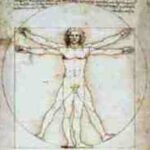Leonardo da Vinci is famous as a painter, sculptor and inventor, but he also plays a large role in the development of knowledge about anatomy and the human body. In fact, even today-more than five hundred years after it was create-there is probably no more recognizable drawing of the human body than Leonardo’s “Vitruvian Man.”
“Vitruvian Man” is the instantly recognizable drawing of a male placed within a circle who seems to have four arms and four legs. In fact, the drawing is supposed to represent the same man superimposed in two different positions. Like everything else with which Leonardo da Vinci was associated, this drawing has a mathematic basis to it. In it, Da Vinci was attempting to enforce a scientific method using mathematical laws onto the human anatomy. Da Vinci didn’t just draw the man in the picture, he also kept notebooks that kept accurate measures of the proportions of all parts of the body, trying to discover a universal perfection of proportions.
Leonardo Da Vinci’s interest in anatomy and the proportions of the body dates back to his apprenticeship with Andra del Verrocchio. Da Vinci’s teacher was insistent that all his students study the human anatomy. Once he became a successful artist in his own right, Leonardo took his interest a step further. Given permission by a hospital in Florence, Italy, Leonardo began to study the body through dissecting corpses. Later he engaged in a partnership with a doctor and the two of them studied the body’s of dissected corpses for the next thirty years. Why go through all this trouble?
Da Vinci was a scientific genius as well as an artistic one. Although the study of the proportions clearly helped with his perspective in painting and sculpture, he also wished to compile a book that contained both his drawings and his observations to be used in the medical field. Medicine at the time was a backward science of ignorance and Leonardo hoped that the discoveries of Renaissance would move beyond the arena of art to the arena of medicine. In addition to studying the proportions of the human body, Leonardo Da Vinci also studied many animals.
In order to compile this book, after dissecting the bodies Da Vinci would set to work writing in his notebooks and drawing. He began with the skeletal structure and his drawings served as the first anatomically correct study, becoming the very first person ever to write down descriptions of various parts of the skeleton, such as the backbone. Leonardo was also the first to recognize and notate that the sacrum was built by the fusion of vertebrae and was not uniform.
After studying and reporting on the skeletal structure, Leonardo Da Vinci moved into the body, composing many drawing of such internal organs as the lungs, liver and sexual organs. Leonardo Da Vinci’s work in studying the proportions of the body were far ahead of his time, but set the stage for all study of the human body to come. There was, of couse, no way to study the interior of the body before X-rays without opening up the bodies of corpses. Although it may have seemed ghoulish to many, Leonardo’s work stands as one of his greatest accomplishments. Just as Da Vinci’s his painting and inventions were well ahead of their time and have lasted for centuries, so was his study of the proportions. It is a testament to Leonard Da Vinci’s work that his iconic drawing is so instantly recognizable around the world, even if people aren’t necessarily aware of what it means or who drew it.
Equally important in understanding the full impact of Da Vinci’s study of the human body is that he did not merely study it for how it was put together, but how it worked. Leonardo’s studies included those whose bodies were diseased or deformed as as well as those who were in good health. Da Vinci’s studies also led him to create theories on how such bodily functions as the flow of blood and male erections took place. Leonardo Da Vinci’s impact on the study of anatomy can be felt today in the development of artificial organs and limbs, proving that even a work of art can have an impact on the scientific world.



